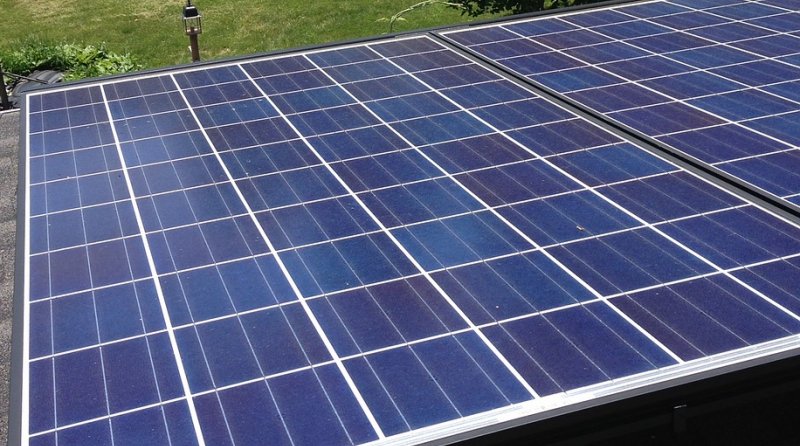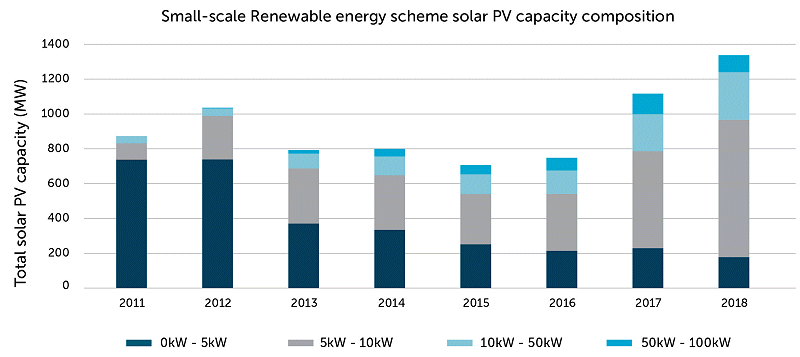
193,960 small-scale (<100kW) solar PV installations with a combined capacity of 1,337 megawatts had been validated this year as at last Monday says the Clean Energy Regulator.
The Regulator released its Small-Scale Technology Certificate Market Update on Friday.
It expects a final total of at least 1,600 MW of small-scale solar PV capacity will have been installed overall this year, due to a reporting lag caused by a creation rule for Small-scale Technology Certificates (STCs). These certificates form the basis of Australia’s major subsidy (aka the solar rebate). While the subsidy is usually offered as an up- front discount to system purchasers, the certificates cannot be created until after the system is installed – and there’s a 12-month period post-installation during which STCs can be generated.
The Regulator states that based on certificate creation, there has been a 31 per cent increase in the number of solar power installations and a 49 per cent jump in total capacity compared to the same period in 2017.
System Capacities Continue To Increase
Major drivers of the increases this year were activity in the 6-7kW and 10-100kW system segments.
6-7kW system installations jumped 135 per cent and capacity by 138 per cent. This isn’t a surprise as a 6.6kW solar power system currently provides the best bang for buck. The Regulator also notes 6-7kW systems had the highest uptake in association with concurrent solar battery storage.
In December last year, 5kW systems still ruled the roost here on SolarQuotes with regard to interest from potential purchasers using our quoting system. It wasn’t until September this year that 6kW overtook 5kW, but preference for 6kW and larger capacity pulled ahead of 5kW back around May.
It’s been encouraging to see more Australian businesses also embracing small-scale commercial solar power this year. 10-100kW systems accounted for 9 per cent of installations and 28 per cent of capacity to December 17, representing a 72 per cent and 61 per cent increase respectively compared to the same time last year.
Clearing House STC Surplus
STCs can be sold on the open market, or the STC clearing house where the price is set at $40 (not including GST). STCs are purchased by liable entities, including electricity retailers. Each year, a percentage is set that dictates how many STCs liable entities must surrender in order to meet their Small-scale Renewable Energy Scheme (SRES) obligations – this is called the Small-scale Technology Percentage (STP).
The Regulator estimates there will be a 6-8 million STC clearing house surplus by the end of the year, compared to the 2018 STP. Clearing house purchases saw little activity this year with just 142,440 certificates sold to date compared to 2.3 million in 2017. Some of the STCs still for sale date back to November last year.
While large surpluses often result in lower STC spot prices (which then impacts the level of solar subsidy available), the Regulator states the STC spot price increased since its October update – from $34.80 to $36.40 at 17 December 2018 based on figures supplied by TFS Green.
Green Energy Markets’ latest spot price (as at closing December 20) was $36.50. Trade In Green’s December 21 price was $34.50. Whether this pricing range can be sustained into 2019 remains to be seen.
More from the STC Market Update can be viewed here.


 RSS - Posts
RSS - Posts



Interesting reading as always!
Good to see the larger systems uptake but I have to ask, are there genuinely homes that can fit all this in a single array and on a single aspect?
Are the installers using this marketing to then upsell to a MPPT inverter or micro inverter set up?
In October 2019 (10months from now) I will have 1.65kw BIPV with a Fronius inverter and will have a need to add 5.5-6kw to the north aspect. I’m torn between Enphase micro inverter or Fronius again. It is a clear (no shading) N aspect.
Then again, adding 2Kw to the east facing roof has its appeal too, but there are a few variables to consider.
Happy to hear thoughts on my comment and also proposed options in 2019.
Will STC values actually drop from Jan 1, thus creating a new sweet spot?
There are plenty of homes where it will be difficult to fit over 6 kilowatts of panels. But this can be done in two aspects as almost every 5 kilowatt inverter has two Multiple Power Point Trackers (MPPTs). And as panels have increased in wattage it easier to fit them on. Panels with 290 watts capacity can be had at a reasonable price and only 22 are required for 6.38 kilowatts. If people are willing to pay extra for 330 watt panels only 20 are required for 6.6 kilowatts.
If your north roof has no shading then Fronius is likely to be cheaper than microinverters. Microinverters will have a small advantage as they handle the effects of dirt better but they may only result in 1-2% greater output depending on local conditions. If you have 3 phase power you will have no problem installing 5.5-6 kilowatts.
A 2 kilowatt east facing system will produce roughly 14% less output than an identical north facing system. Provided you can afford the larger north facing system I’d say go with that as it will provide a greater return, both because north facing panels will have greater output and because the larger system will be cheaper per watt to install.
The amount of STCs received will decrease by 7.3% on the first of January, but this will only result in an increase in price of 2-3%. Given that, on average, solar is still continuing to fall in price this may not even be noticeable.
Thanks, the north facing system will be priority after the build. The 2Kw east aspect might have to link up with the West aspect 1.7kw BIPV on the same Fronius inverter. Should that work?
Also, any suggestions on combining the monitoring of multiple systems.
Thanks
Happy New Year’s Eve, Glo.
Putting east and west facing panels on the same MPPPT tracker, especially when they are different types of panels is not recommended, as the mismatch in their output will lower performance. While it has been done with identical panels the conditions need to be pretty much spot on for it to be effective. Working from memory, a Fronius inverter should not have a problem with 5.5 to 6 kilowatts of panels facing north on one MPPT and 2 kilowatts of east facing panels on its other MPPT. They can handle considerable variation in array size. The inverter will have to be large enough so the total panel capacity is not more than one-third greater than the inverter capacity.
For monitoring across multiple systems you can pay for a third party monitoring system:
https://support.solarquotes.com.au/hc/en-us/articles/115001271874-What-third-party-energy-monitoring-solution-should-I-buy-
Note that some people love these monitoring systems while others soon end up ignoring them so whether or not it is worth it will depend on your personal preferences.
Can you tell us about integrated solar roof products like Tedlas and 3in1 from USA availability in Australia?